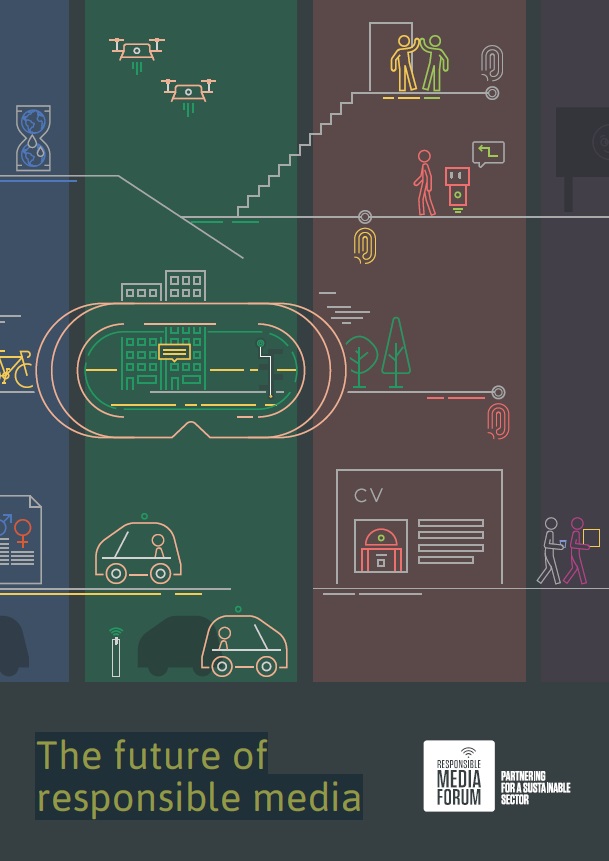The future of responsible media
Executive Summary
Based on insights generated from desk research, interviews, conference exercises and a decade of expert presentations to the Responsible Media Forum, this report attempts to identify the biggest corporate responsibility challenges facing media companies over the next 10 years. We believe that companies’ responses to these challenges will separate ‘good’ companies from the ‘bad’. Our aim is to provoke a wider discussion on the future responsibilities of media companies, hopefully giving those working in the sector a heads up on what is to come, and the inspiration and confidence to prioritise differently.
The media sector is incredibly diverse – broadcasters have little in common with exhibition organisers, for example. Consequently, the future challenges identified do not apply evenly across the sector, and the means by which ‘solutions’ can be reached vary accordingly.
In section 1we take stock of how media companies have managed their social and environmental responsibilities since the early 2000s. We note that the sector has come a long way. Companies have more ambitious CR programmes in place, dedicate more financial and human resource to manage their responsibilities and generally have a better understanding of their unique impacts on society. On the other hand, the sector is still in the process of finding its feet, grappling with measuring, let alone managing, its content and other core impacts.
In section 2 we identify eight social and technological forces that together will transform the media landscape(s) of the future. The focus in this section is not on CR but rather the more fundamental changes that will affect business models and the very notion of what it means to be (and succeed as) a media company. The forces all share a common underlying theme, and that is media’s shift to digital. The eight forces are:
FORCE 1 – INNOVATE OR PERISH The rise of the ‘Frightful Five’ 1 – Amazon, Apple, Facebook, Google and Microsoft – whose ambition and expansion have challenged existing business models, has created an arena where the ability to innovate has truly become a survival trait.
FORCE 2– MOBILE WILL (CONTINUE TO) EAT THE WORLD The rise of audiences accessing content through their phones or mobile devices is set to continue. By 2020, more than five in six of the World’s adults will own a smartphone.
FORCE 3 – THE ON-DEMAND ECONOMY: ACCESS WILL OVERTAKE OWNING Consumers are spending less to buy and own media content – such as digital downloads – while spending more to gain access, predominantly through digital streaming services. This will require a fundamental rethink of how media content is packaged, priced, marketed and sold.
FORCE 4 – THE BOUNDARY BETWEEN TECH AND MEDIA (AND EVERYTHING ELSE) WILL DISAPPEAR Media companies will no longer just be competing with media companies; new entrants may spring up from a whole host of industries.
FORCE 5 – PARTNERSHIPS AND ALLIANCES WILL DOMINATE HOW BUSINESS IS DONE In a data-driven world where scale and the pace of innovation are key, media companies will need to strike up collaborations, even with competitors.
FORCE 6 – THE PERSONALISATION OF EVERYTHING The combination of cheaper, more effective processing power, advances in machine learning and the proliferation of internet-enabled devices is taking media companies into new territory. The rise of bots spells the dawn of an era of personalisation and intuitive human-machine communication.
FORCE 7 – REALITY CHECK: FORGET EVERYTHING YOU KNOW ABOUT INTERACTING WITH MEDIA Augmented Reality (AR) and Virtual Reality (VR) will open up entirely new ways of exploring media content, and they are likely to spawn whole new industries around hardware, marketing, content creation and distribution.
FORCE 8 – ADVERTISING IN EVERYTHING: THE SEGMENT OF ONE COMING OF AGE Advertising will get ever more up close and personal, with personal data continuing to emerge as a precious asset. Media companies will struggle to benefit from this unless they manage to wrestle back control from the two “800-pound gorillas in online advertising”. In section 3 we bring together the insights from the two previous sections. We articulate how the current state of CR (section 1) is likely to be impacted by the eight transformative forces (section 2) and in turn what the specific CR challenges arising from those impacts will be. This leads us to formulate four interrelated future CR challenges:
CHALLENGE 1 – THE FUTURE OF PRIVACY More so than now, media companies of the future will actively collect and use personal data. The upside is clear: delivering fully personalised and compelling content for the enjoyment of everyone. The downside relates to data ownership and privacy. Media companies will need to step up their approach to cybersecurity and data privacy.
CHALLENGE 2 – COMING TO GRIPS WITH BEING MOVERS Media companies exercise an enormous influence through their content, be it through data, advertising, (fake) news or entertainment. When analysed through the lens of CR, media’s content is probably its biggest effect on society. Yet, in the face of society increasingly holding corporations to account for their social impacts, the sector will continue to struggle managing this undefined and ever changing responsibility.
CHALLENGE 3 – MEDIA COMPANIES MUST BECOME ORGANISATIONS WITHOUT WALLS The media landscape is turning into a more fluid business environment, where jobs previously done by media companies will be pushed back on to partners or ‘frenemies’. This poses new challenges around community partnerships, degrees of control within the value chain, and measurement of environmental impacts, particularly as they relate to digital.
CHALLENGE 4 – GET WITH THE PROGRAMME: MANAGING THE WORKPLACE OF THE FUTURE There are and will be significant gaps emerging as the job market is unable to provide the critical skills needed to deliver on and develop digital strategies. Media will compete with many more industries for critical talent, forcing the sector to rethink existing notions of ‘purpose’, ‘progression’ and ‘hierarchy’. Companies will also need to do a better job of providing opportunities to people from different backgrounds.
To conclude, in section 4, we ask the question, what does it all mean? In response to this question, we draw out nine lessons for media CR professionals interested in future-proofing their company.
To download the full report, please click here.

